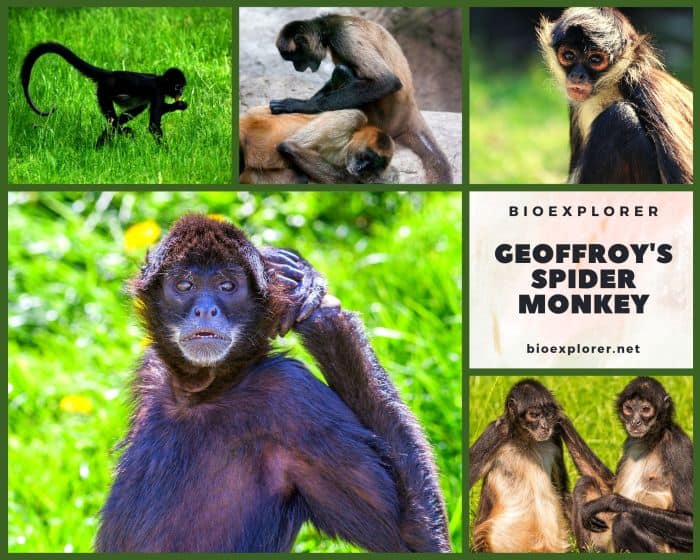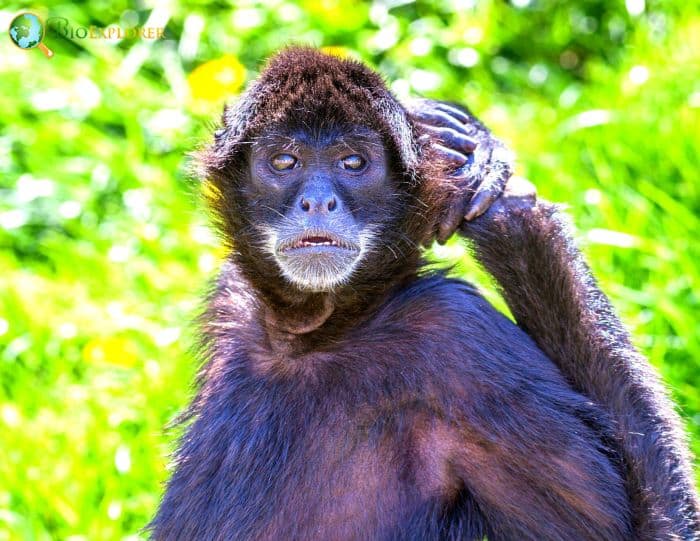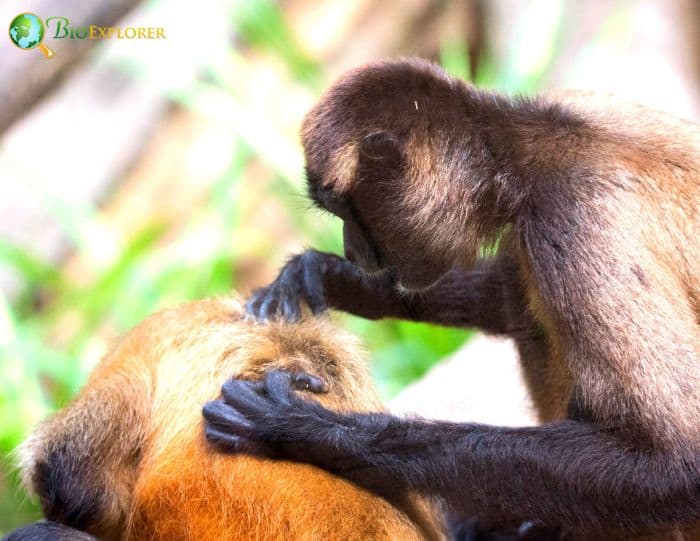
| Animalia | Primates | Atelidae | Ateles | Ateles geoffroyi |


- Common Name: Central American Spider Monkey
- Taxonomy Classification Year: 1820
- Monkey Size: 30 to 63 cm (12 to 25 in)
- Skin Color(s): Black, brown, or reddish
- Habitat: Forest, rainforest
- Diet: Herbivorous
- Native Countries: Mexico, Costa Rica, Belize, El Salvador, Honduras, Guatemala, Panama, Nicaragua
Central American Spider Monkey Distribution
Geoffroy’s Spider Monkey Characteristics

Geoffroy’s spider monkey[1] also called the Central American spider monkey or black-handed spider monkey, is a species of spider monkey, a New World species of monkey, native to Central America, parts of Mexico, and perhaps a small part of Colombia.
- Like other monkeys and great apes, Geoffroy’s spider monkeys have large, opposed toes on their feet that can quickly grab branches.
- As the name suggests, these monkeys have black hands and feet. Their fur coats vary in color from tan to black or reddish brown.
- Babies are born black, but their fur lightens in the first five months of life. After that, a small head rests on a flexible body.
- Their expressive faces are hairless, with unpigmented skin framing the eyes and muzzle in a pale facial mask.
What Do Geoffroy’s Spider Monkeys Eat?

According to the study published[¶], the Geoffroy’s spider monkey feeds on several plant matters, including these prominent sources:
- Breadnut (Brosimum alicastrum)
- Strawberrytree (Muntingia calabura)
- Gumbo Limbo (Bursera simaruba).
- Cedro Macho (Aralia excelsa).
- False Chiggergrape (Coccoloba venosa).
- Icecreambean (Inga edulis)
- Mango (Mangifera indica)
- Jagua (Genipa americana)
- Pachiuba (Socratea exorrhiza)
- Requia Colorada (Trichilia cipo).
- Panama Hat Plant (Carludovica palmata).
- Smooth Manjack (Cordia laevigata).
- Pumpwood (Cecropia peltata)
- Malaysian Apple (Syzygium malaccense).
- Guarumo (Cecropia obtusifolia)
- Conejo (Protium tenuifolium)
- Guabo Pachón (Inga goldmanii).
- Star Apple (Chrysophyllum cainito).
- Angelica Tree (Dendropanax arboreus).
- Abas (Psidium guajava)
- False Coffee (Faramea occidentalis).
- Panama Tree (Sterculia apetala).
- Guarumo Amarillo (Cecropia longipes).
- Amate (Ficus obtusifolia)
- Hogplum (Spondias mombin)
- Chirimoya (Annona spraguei)
- Puerto Rico Silver Palm (Coccothrinax barbadensis).
What Eats Geoffroy’s Spider Monkeys?
Two main predators of this Central American primate are jaguars (Panthera onca) and Cougars (Puma concolor)[§].
Geoffroy’s Spider Monkey Facts
- The genus name Ateles means “imperfect“, a reference to the vestigial thumb of the monkey.
- The species name geoffroyi is honored by Étienne Geoffroy Saint-Hilaire, a French naturalist.
- Primatologists believe that the enlarged clitoris of female Geoffroy’s spider monkeys helps males decide which female to approach for mating. It allows the male species to gauge a woman’s sexual receptivity.
- Geoffroy’s spider monkeys’ modes of locomotion include walking, climbing, or crawling along delicate branches, swinging from one branch to another.
- Often, they rub their fur with a mixture of saliva and crushed linden leaves as a natural insect repellent.
- The Geoffroy’s spider monkey consists of five recognized subspecies residing in various parts of Central America and Mexico. These include the Hooded spider monkey (A. g. grisescens) in southern Mexico, the ornately-patterned Ornate spider monkey (A. g. ornatus) in Costa Rica and Panama, the Yucatan spider monkey (A. g. yucatanensis) in the Yucatan Peninsula, the Mexican spider monkey (A. g. vellerosus) in Veracruz, and the nominate Nicaraguan spider monkey subspecies (A. g. geoffroyi) found in Nicaragua, Honduras and northern Costa Rica.
Suggested Reading: All Monkeys
Cite This Page
APA7MLA8Chicago
BioExplorer.net. (2025, January 03). Geoffroy’s Spider Monkey. Bio Explorer. https://www.bioexplorer.net/animals/mammals/monkeys/geoffroys-spider-monkey/.
BioExplorer.net. "Geoffroy’s Spider Monkey" Bio Explorer, 03 January 2025, https://www.bioexplorer.net/animals/mammals/monkeys/geoffroys-spider-monkey/.
BioExplorer.net. "Geoffroy’s Spider Monkey" Bio Explorer, January 03 2025. https://www.bioexplorer.net/animals/mammals/monkeys/geoffroys-spider-monkey/.
















